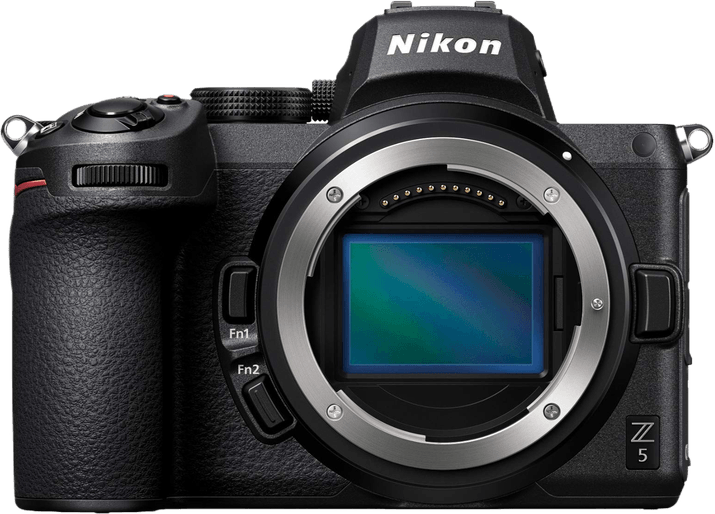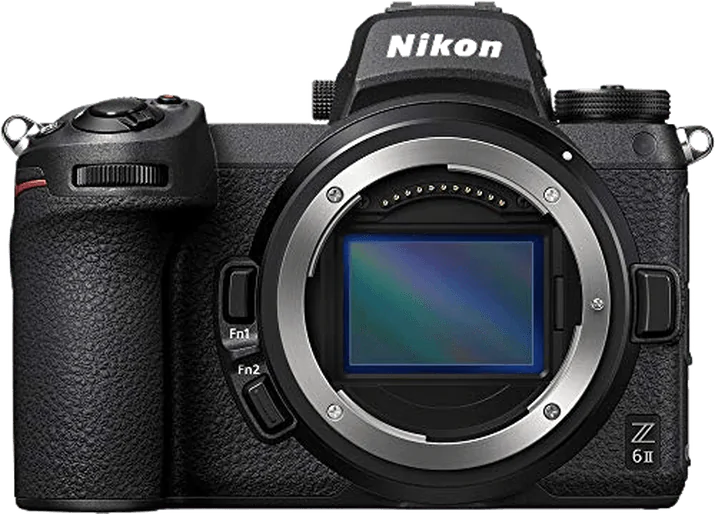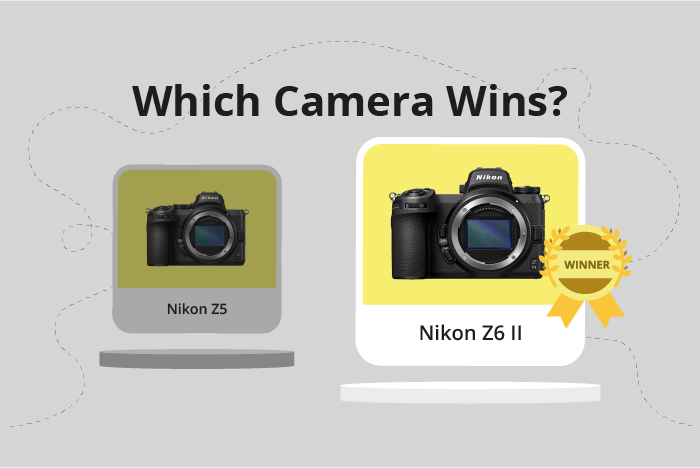Nikon Z5 vs Z6 II Comparison
Nikon Z5

Nikon Z6 II

The Nikon Z6 II emerges as the winner with a score of 83/100, whereas the Nikon Z5 scores 78/100. Both cameras are mirrorless and were released in 2020, with the Z5 being announced in July and the Z6 II in October. They share similar dimensions, with the Z5 measuring 134 x 100.5 x 69.5mm and the Z6 II at 134 x 101 x 70mm. The Z6 II is slightly heavier at 705g compared to the Z5’s 675g.
The Nikon Z6 II’s higher score showcases its superior performance and features. However, the Nikon Z5 has its advantages, such as a lower launch price of $1400 compared to the Z6 II’s $1995. This makes the Z5 a more budget-friendly option for those seeking a quality camera without the higher price tag.
Considering the specifications and scores, the Nikon Z6 II is the better camera, but the Nikon Z5 offers a more affordable alternative without sacrificing too much in terms of quality and performance.
Nikon Z5 vs Z6 II Overview and Optics
The Nikon Z6 II takes the lead in optics with a score of 83/100, compared to the Nikon Z5’s score of 81/100. Both cameras share several specifications, including a CMOS sensor, full frame sensor size, Nikon Z lens mount, and image stabilization. However, there are key differences that contribute to the Nikon Z6 II’s superior optics.
The Nikon Z6 II excels with its 24.5-megapixel count, slightly higher than the Z5’s 24 megapixels. This advantage allows the Z6 II to capture more detail in images. The Z6 II also has a faster shooting speed of 14 frames per second, compared to the Z5’s 4.5 frames per second. This makes the Z6 II a better choice for action photography and situations where rapid image capture is necessary. Additionally, the Z6 II features a dual Expeed 6 processor, providing faster processing and better overall performance.
On the other hand, the Nikon Z5 has a higher DXOMARK score for the sensor at 97, compared to the Z6 II’s 94. This means the Z5’s sensor performs better in terms of color depth, dynamic range, and low-light performance. However, this advantage is not enough to outweigh the benefits offered by the Z6 II.
In comparing the optics of these two cameras, the Nikon Z6 II comes out on top due to its higher megapixel count, faster shooting speed, and dual Expeed 6 processor. While the Nikon Z5 has a slightly better sensor performance, the Z6 II’s advantages make it the better choice for most photographers.
Nikon Z5 vs Z6 II Video Performance
The Nikon Z6 II outperforms the Nikon Z5 in video capabilities, scoring 91/100 compared to the Z5’s 83/100. Both cameras share some common specifications, including a maximum video resolution of 4K and maximum video dimensions of 3840 x 2160. Additionally, both the Z5 and Z6 II have built-in time-lapse functionality.
The Z6 II’s superior video performance is due to its higher maximum video frame rate of 120fps, double that of the Z5’s 60fps. This allows the Z6 II to capture smoother slow-motion footage, providing more creative options for videographers. The increased frame rate also contributes to better overall video quality and performance, justifying the higher score.
The Z5, despite its lower score, still offers solid video capabilities. Its 4K resolution and time-lapse functionality ensure that it can capture high-quality footage for various purposes. However, the lower frame rate may limit its appeal to videographers seeking advanced slow-motion capabilities.
While the Z6 II is the clear winner in terms of video performance, the Z5 remains a reliable option for those who do not require the advanced slow-motion capabilities offered by the Z6 II. Both cameras deliver 4K resolution and time-lapse features, ensuring quality video capture for a range of users. Ultimately, the choice between the two models depends on the specific video requirements and budget of the potential buyer.
Nikon Z5 vs Z6 II Features and Benefits
The Nikon Z6 II outperforms the Nikon Z5 with a feature score of 87/100 compared to the Z5’s 72/100. Both cameras share some common specifications, such as a 3.2-inch screen size, touchscreen capabilities, and the absence of GPS. Additionally, both cameras are equipped with Wi-Fi and Bluetooth connectivity.
The Nikon Z6 II surpasses the Z5 in screen resolution, boasting 2,100,000 dots compared to the Z5’s 1,040,000 dots. This higher resolution provides the Z6 II with a clearer and more detailed display, enhancing the user’s experience when composing and reviewing images. However, the Z5 has an advantage with its flip screen feature, which is absent in the Z6 II. The flip screen allows for greater flexibility when shooting from different angles and can be particularly useful for vlogging and self-portraits.
While the Nikon Z5 does have the flip screen advantage, the overall higher feature score of the Z6 II indicates that it is a superior camera in terms of performance and capabilities. The Z6 II’s improved screen resolution contributes to this higher score, offering a better visual experience for the user.
In comparison, the Nikon Z5’s lower feature score suggests that it may not perform as well as the Z6 II. However, the flip screen feature should not be overlooked, as it offers a unique advantage for specific shooting scenarios. Ultimately, the choice between the two cameras depends on the individual’s needs and priorities, with the Z6 II providing a better overall experience and the Z5 offering a specific advantage with its flip screen.
Nikon Z5 vs Z6 II Storage and Battery
The Nikon Z5 wins in storage and battery with a score of 73/100, while the Nikon Z6 II scores 71/100. Both cameras share common specs, such as two memory card slots, compatibility with UHS-II cards, the use of the EN-EL15c battery type, and USB charging capabilities.
The Z5 outperforms the Z6 II in battery life, offering 470 shots compared to the Z6 II’s 410 shots. This longer battery life makes the Z5 more suitable for extended shooting sessions without needing frequent battery replacements.
On the other hand, the Z6 II accepts both SD and CFexpress Type B/XQD cards, providing greater flexibility in storage options compared to the Z5, which only accepts SD/SDHC/SDXC cards. This advantage, however, does not outweigh the Z5’s superior battery life.
In the realm of storage and battery, the Nikon Z5 proves to be the better choice due to its longer battery life, despite the Z6 II’s broader memory card compatibility.
Alternatives to the Nikon Z5 and Z6 II
Are you still undecided about which camera is right for you? Have a look at these popular comparisons that feature the Nikon Z5 or the Nikon Z6 II:

